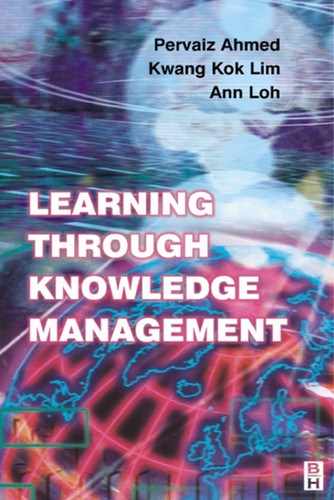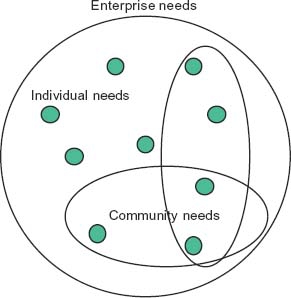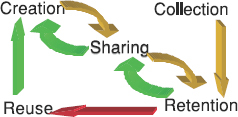11
CMG
CMG plc is a leading information and communications technology (ICT) services group, providing business information services and wireless data solutions through management consultancy, systems development and integration, software applications and managed business processes. Established in 1964, CMG operates internationally from its European bases in The Netherlands, the UK, Germany, France and Belgium, implementing and supporting applications for clients around the world. The company has grown from a seven-man company to a company of over 12 000 employees in sixteen countries. CMG is listed on the London and Amsterdam stock exchanges with a valuation of over £2 billion.
Rapid growth during recent years has required CMG to find new ways to bring people, and what they know, together.
CMG: a knowledge maker
The CMG view is that different organizations value and use knowledge differently. Therefore, to understand CMG's approach to knowledge management, one first needs to be aware of what type of business CMG is.
CMG classifies itself as unquestionably a knowledge business, i.e. knowledge makers who acquire and resell know-how. This type of organization makes money by selling knowledge, advice and experience through specialized skills. They constantly need to identify new opportunities. The information culture is informal and bottom up. Business growth relies on innovation, creativity and more people. People – employees – are seen as their primary asset. Knowledge makers want information about markets and people. Empowerment is important, as is morale and job satisfaction. Communications systems are also important.
Each of its employees across the globe is deemed to have the knowledge, skills and experience that represent CMG's products and knowledge assets. CMG has some specific priorities in managing knowledge that suit their type of organization. Foremost is the recognition that the individual owns knowledge, not the enterprise.
CMG's organization
People are CMG's key asset. Their core business processes are designed to find and keep the best people in order to sell their skills, knowledge and experience.
The organization has a flat structure and grows organically. Divided into many small divisions, i.e. ‘companies’ of around 100 people, new companies are formed when a company grows too big and splits into two. An entrepreneurial approach means that managing directors effectively run their own business within the CMG framework sharing resources with the other companies. Like all members of CMG, the directors are measured on their success, but everyone participates in the success of this family style enterprise. More than half of CMG's employees have an equity interest in the business.
CMG's culture
CMG is all about people. It has a very strong culture dating back to its foundation in 1964. Its culture is based on equity, fairness, accountability, openness and honesty.
An environment of trust is created by a culture where everyone gets the same benefits – the same open plan ‘hot-desk’ offices (where people may sit in a different desk every day) – and there are no special executive benefits. The only difference between consultant benefits is their salary – and these are not kept secret. Each consultant has to prove their worth among his or her peers, and financial rewards are frequently reviewed to ensure this.
Barbara Ward, founding member and previous Group Director commented, ‘We have always been a company that has encouraged people to want to know what is going on because we feel very strongly that if you want people to keep committed you have got to keep them informed’. Except for group financial results, there are no locked cabinets or files, so consultants can have direct access to practically any file they want. They can review the director's personnel file at leisure, or comment on documents they may read on another's desk or screen.
The culture is perpetuated through many social occasions where stories are told, and heroes are celebrated. There is, nonetheless, a conservative dress code, and professionalism is very important. However, most networking at CMG is done at these social events where it is possible to meet new people and find new opportunities.
Consultants are responsible for their own success at CMG, so they must network continuously with others to find projects and opportunities for more work. Traditionally, this networking is done during team meetings and social occasions on a face-to-face basis (perhaps over a beer).
CMG has grown so rapidly in recent years, however, that it is not possible to personally meet everyone else. In order to maintain its culture, CMG also relies on technology to keep everyone connected. The sort of things that consultants would talk about in a group needed to be facilitated across the world, and between people who may have never met before – hence, intranet technology was used to meet this need.
Developing the knowledge intranet
Intranet technology is used to empower individuals and reinforce the corporate culture. A suite of intranet tools enable consultants to collect, store, share, reuse and create knowledge in self-administered communities of interest.
CMG recognized that to manage knowledge, it must first have the support of its people, and that meant meeting their individual and community knowledge needs. Since people own knowledge, they must be at the centre of any approach to knowledge management. Figure 11.1 shows the three need domains considered for knowledge in CMG.
Starting with individual needs, CMG considered what people wanted to do with their knowledge, and how they wanted to manage it. CMG people were most interested in the ability to network with other CMG people. This need was expressed as a desire to find people with similar professional interests to develop knowledge and relationships, or people with business opportunities to jointly exploit. People wanted to find experts and case studies (stories) about clients, processes or techniques used within CMG. They also wanted the freedom to organize their own approach to sharing what they knew.
Communities, which form informally and organically in CMG, are an important element of sharing and creating knowledge. The community, or ‘special interest group’, is also an important ‘greenhouse’ of new products, services and methods for CMG. Communities are groups of people with some common interest or objective. To belong to this type of group, members must be willing to expend effort in sharing and/or learning. In the past, these communities were limited to people who knew each other and worked in the same office. Communities would benefit from the intranet by removing this barrier and enabling a much wider group of potential members and allow more communities to form. Identity, freedom and flexibility were important to communities.
Fig. 11.1 Different needs in knowledge management
CMG's enterprise needs for acquiring and using knowledge are now being addressed. Business processes relating to clients, people and operations were identified for ‘knowledge enabling’. CMG found that enterprise needs required more formal and procedural knowledge to be collected from individuals and formal work groups, but the basic skills of collecting and disseminating by people were always required.
Enterprise knowledge applications are seen as a specific requirement of knowledge use to meet company goals (such as key account management). This is done by applying the set of basic skills, or functions, already used by individuals to a targeted business process. These applications will attempt to:
- capture people's knowledge and experience as a process input
- capture and reuse process outputs
- involve more people in the process to increase learning and knowledge creation.
The CMG approach is a ‘walk before you run’ method. People are empowered to use new knowledge tools before these are applied to the needs of the enterprise.
Basic functions and attributes of knowledge management
The basic functions of collecting, storing, reusing, creating and sharing knowledge are considered the enablers of knowledge management (Figure 11.2). People at CMG must be able to perform these before other knowledge-based problems can be addressed. (The tools that enable them to perform these functions are described further on in this chapter.)
Through self-examination and looking at other companies, CMG found a number of generic knowledge management system attributes, i.e. a knowledge management system should be:
1 Customizable. People want a degree of control over the layout, structure, content and processes of their own solutions. People want to be responsible for their knowledge.
2 Flexible. Businesses do not want to be locked in to any one product or architecture. The knowledge and information captured by a knowledge management solution must still be used by other systems.
3 Scalable and extendable. Some companies want to be able to share selected knowledge and information with customers or suppliers via an extranet or e-commerce. It was important to have a platform independent solution to enable this.
A tool-kit approach
CMG took a tool-kit approach to knowledge management. This meant that a common set of tools could be used to build a whole variety of structures that suited different parts of the organization while performing the basic functions of knowledge management. Knowledge and information captured, created, shared and stored would be available to applications designed to meet enterprise knowledge management needs (like competitive intelligence systems and key account management).
Fig. 11.2 Basic functions of knowledge management
Everyone needed to be linked together so the best applications could be shared across the group, and the system needed to be simple enough for them to share knowledge with partners regardless of their own systems. Beyond the basic intranet infrastructure (the ‘plumbing’), connecting all CMG people, web browsers and databases, the CMG knowledge intranet tool-kit provides:
- facilities to collect and store knowledge, both tacit and explicit
- facilities to capture and store information from external sources or other applications, such as news feeds, etc.
- facilities to help people create and share their knowledge, network with experts or discuss ideas
- applications to retrieve relevant information and knowledge to answer questions or stimulate innovation
- applications to create, manage, audit and report on any system facility or application.
Using the knowledge intranet tool-kit
Five main tools enable CMG people to create a number of different approaches to sharing and managing knowledge:
- auto-publishing
- subscribe and search
- site management
- Team Web and discussion forums
- interpersonal networking.
Auto-publishing
This tool is an e-mail based publishing method that enables every person in CMG to share documents and other files on the intranet. Anything is allowed from ideas and opinions to reports and analyses. Because consultants do not always know who else will find some information valuable, the e-mail based auto-publisher means consultants can copy an e-mail to the intranet or a discussion forum for anyone to see. Users can also manage their own published material.
Every document, without exception, has an owner who is clearly identified. This owner is always a person, and that means there is always a link between the published information and the person with the knowledge that created it. This means people are connected with people and not just documents – a major difference to most other systems.
Subscribe and search
CMG consultants want to be able to locate other people, information and knowledge easily. They want to participate in communities. The search function helps them find published content using keywords and meta-information (like document type, subject area, author, etc.), while the subscribe function means they will be notified when a document is published in an area of the Internet that they are interested in.
Site management
The site management tool enables individuals and communities to choose how to organize their knowledge on the intranet. It means that anyone can create a sub-branch employing any categories, links or tools they choose. The ‘look and feel’ or graphical interface can also be customized.
Team Web and discussion forums
Team Web is the virtual community in CMG. Team Webs are substructures of the intranet created by one or more consultants who have an interest in a specific area of technology, a market or process. Examples of Team Webs that have formed on the CMG knowledge intranet include: The Oracle Focus Group, EMU SIG and Business Intelligence Technology Systems.
Team Webs create opportunities for consultants to meet people with similar interests and are a place to centralize, store and create more knowledge. Often, they lead to new business for CMG too.
Interpersonal networking
People-to-people networking is still the primary way of doing business in CMG. The entire approach to knowledge management has been about creating more opportunities for people to interact with each other and the knowledge.
The intranet also enables CMG to promote awareness of more and more opportunities for CMG people to meet face to face in a social format. The flexibility afforded by this tool-kit approach means people can publish their own knowledge, create their own structures, network with other people and share knowledge.
Lessons learned
Approaching knowledge management for the first time, a business organization should consider what type of business they are. Knowing how knowledge is used and valued by the enterprise will help determine the real knowledge needs.
Careful consideration should be given to individual, community and enterprise needs for knowledge. People have to manage their own knowledge. The enterprise should empower people to manage individual knowledge before attempting to use collective knowledge to meet superordinate enterprise goals.
Because people are essentially social, or tribal, by nature, the ability to create knowledge communities by groups of individuals is a valuable step towards enterprise-wide knowledge application. This ‘walk before you run’ strategy will enable behavioural and cultural changes to take place more easily as well.
CMG used an intranet tool-kit approach to achieve knowledge management, with successful results – they have one of the lowest staff attrition rates in their industry, and are one of the top performing companies on the London Stock Exchange for share price growth.


